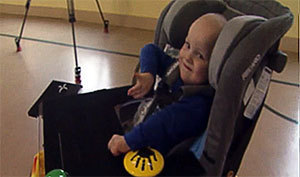According to its website, “Little Tikes has provided countless hours of fun for all ages.” Two University of Notre Dame engineering students used a Little Tikes Hummer car to not just bring fun but to tremendously enrich the life of a young patient at Memorial Hospital of South Bend.
Derek Wolf and Jake Darnell are members of the University’s Class of 2013. During their engineering studies, they were members of SERO (Students Engineers Reaching Out), a group that uses their mechanical, structural, electrical, computer and industrial engineering skills to develop effective, efficient and sustainable solutions for a variety of not-for-profit organizations.
 Memorial Hospital patient Austin Rousselow, 2, drives a Little Tikes Hummer car specially outfitted for him by Notre Dame students
Memorial Hospital patient Austin Rousselow, 2, drives a Little Tikes Hummer car specially outfitted for him by Notre Dame students
“Our group has modified and fixed toys for pediatric therapy for many years with South Bend’s Saint Joseph Hospital and for about one year with Memorial Hospital,” Wolf said.
Elise Gettleman, a physical therapist at Memorial Children’s Medical Center, approached the group with an idea for a project to help Austin Rousselow, age 2, one of her patients who has cerebral palsy.
“Elise had read of the benefits of powered mobility for the development of children in different journals and articles and thought we could do something similar,” Wolf said. “We had never done anything so large for the toys project, but we decided that we could definitely do so.”
“It was a big project, which made it even more attractive to us,” Jake said. “Derek and I, along with help from the rest of SERO, talked about a lot of different ideas for the design. We would basically hold meetings once a week and talk about any challenges that faced us in the process.”
The key modification was to make the car controllable by either a joystick or by pressing a button. Wolf and Darnell replaced the car’s steering wheel with an electric motor and relocated the gas pedal and wired it to buttons.
“The goal was that the entire car could be controlled by Austin’s hands,” Wolf said.
The pair used a car seat to provide a more stable seat and mounted the tray from an electric wheelchair on PVC pipe to allow for adjustable height.
“Austin works better with buttons than joysticks, and the buttons can be stuck with Velcro anywhere on the tray,” Wolf said. “The hardest part was to make the adjustments to tailor the car to Austin. It was from this tailoring that the ideas for adjustable height of the tray, the buttons and the Velcro tray were created.”
The challenges were far outweighed by the rewarding feelings Wolf and Darnell experienced when they delivered the car to Memorial and saw Austin driving it.
“Knowing what we did could really make a difference in his life was beyond anything I expected,” Darnell said. “I knew I was working on a cool project, but I had no idea it would be so rewarding.”
“Seeing Austin use the car was one of the greatest moments of my Notre Dame career,” Wolf said. “We had seen him try to use the joystick with limited success, so when we saw him driving the car on his own, we were quite proud. The smile on both his and his parents’ faces made all the effort worth it.”